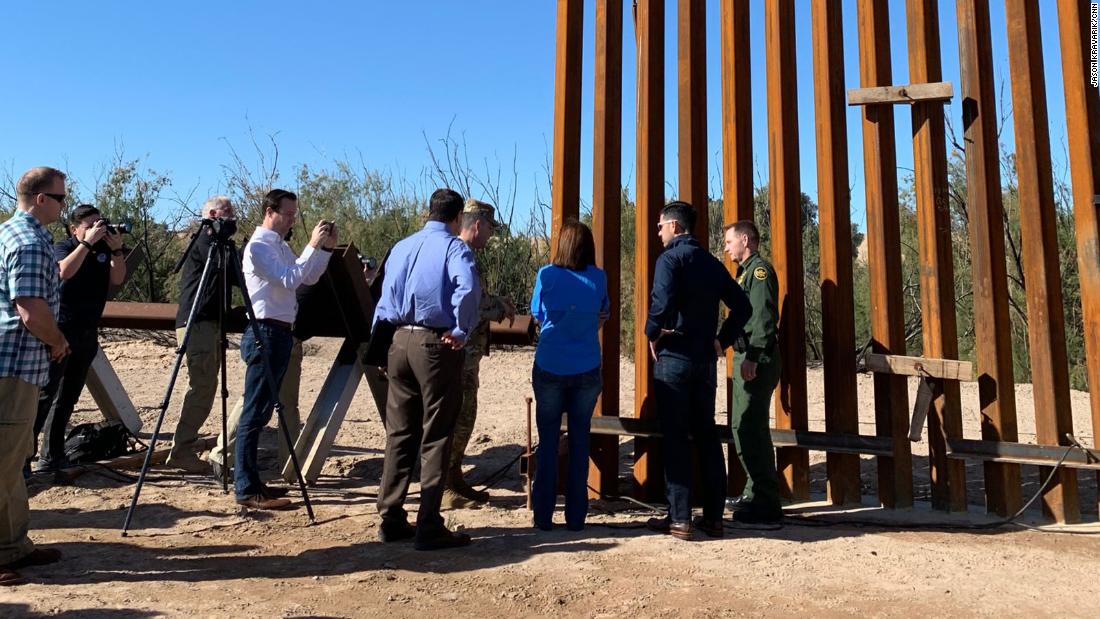US Customs and Border Protection, which oversees border wall construction, is painting approximately 450 feet of new border wall in San Luis, Arizona, using a "coal tar epoxy," in an effort to assess the operational benefits, according to the agency. The border agency is testing for a "coating which will extend the life of steel," a spokesperson told CNN. It will also be tested at the US Border Patrol Academy in Artesia, New Mexico, this summer. If successful, the coating will be used in other locations, the agency spokesperson said. CBP did not immediately respond to questions about how success will be measured. During an Oval Office meeting last year, Trump told various government officials that he wanted the wall to be painted black and to include French-style doors. The idea appeared to die down since. But a few months ago, Trump wanted the wall painted again, according to an administration official. Painting the wall comes at a cost. Depending on what paint is used, it could increase the cost up to $1.2 million per mile, the official said. If paint is applied to all 450 new miles that Trump has said will be built by early next year, the price tag would be roughly $500 million. There doesn't appear to be any significant structural advantage to painting the wall, the official added. In recent months as the coronavirus pandemic has swept across the US, Trump has repeatedly touted the administration's wall construction efforts. But legal challenges have slowed down construction along some areas of the US-Mexico border, as states and organizations push back against the President's signature project.The majority of the administration's efforts along the border so far have been replacing dilapidated barriers with new, enhanced wall systems. As of May 22, the administration constructed 194 miles of new wall, only three miles of which are in locations where no barrier existed before, according to the latest CBP data. Since January 2017, the administration has planned for around $15 billion to build approximately 731 miles of border wall, including around $6.3 billion from Department of Defense funds and $3.6 billion from military construction funds. According to CBP, the US Army Corps of Engineers identified the coating as a way to extend the life of steel, when properly maintained. CBP is responsible for questions about wall design, said a spokesperson for Army Corps of Engineers.Acting Homeland Security Secretary Chad Wolf said earlier this month that the administration is assessing whether to paint the border wall in an effort to extend its lifespan. "We are taking a look at, perhaps, does painting the wall provide a prolonged life of the wall," he said to a group of reporters in Tucson, Arizona. "How do we get a longer lifespan out of the wall? And if that means, if we can paint it and it prolongs the life then we'll do just that."His remarks came after Read More – Source
US Customs and Border Protection, which oversees border wall construction, is painting approximately 450 feet of new border wall in San Luis, Arizona, using a "coal tar epoxy," in an effort to assess the operational benefits, according to the agency. The border agency is testing for a "coating which will extend the life of steel," a spokesperson told CNN. It will also be tested at the US Border Patrol Academy in Artesia, New Mexico, this summer. If successful, the coating will be used in other locations, the agency spokesperson said. CBP did not immediately respond to questions about how success will be measured. During an Oval Office meeting last year, Trump told various government officials that he wanted the wall to be painted black and to include French-style doors. The idea appeared to die down since. But a few months ago, Trump wanted the wall painted again, according to an administration official. Painting the wall comes at a cost. Depending on what paint is used, it could increase the cost up to $1.2 million per mile, the official said. If paint is applied to all 450 new miles that Trump has said will be built by early next year, the price tag would be roughly $500 million. There doesn't appear to be any significant structural advantage to painting the wall, the official added. In recent months as the coronavirus pandemic has swept across the US, Trump has repeatedly touted the administration's wall construction efforts. But legal challenges have slowed down construction along some areas of the US-Mexico border, as states and organizations push back against the President's signature project.The majority of the administration's efforts along the border so far have been replacing dilapidated barriers with new, enhanced wall systems. As of May 22, the administration constructed 194 miles of new wall, only three miles of which are in locations where no barrier existed before, according to the latest CBP data. Since January 2017, the administration has planned for around $15 billion to build approximately 731 miles of border wall, including around $6.3 billion from Department of Defense funds and $3.6 billion from military construction funds. According to CBP, the US Army Corps of Engineers identified the coating as a way to extend the life of steel, when properly maintained. CBP is responsible for questions about wall design, said a spokesperson for Army Corps of Engineers.Acting Homeland Security Secretary Chad Wolf said earlier this month that the administration is assessing whether to paint the border wall in an effort to extend its lifespan. "We are taking a look at, perhaps, does painting the wall provide a prolonged life of the wall," he said to a group of reporters in Tucson, Arizona. "How do we get a longer lifespan out of the wall? And if that means, if we can paint it and it prolongs the life then we'll do just that."His remarks came after Read More – Source










